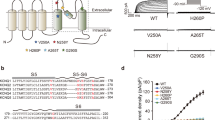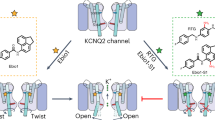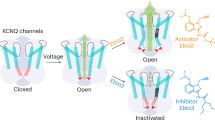Abstract
Aim:
Retigabine, an activator of KCNQ2-5 channels, is currently used to treat partial-onset seizures. The aim of this study was to explore the possibility that structure modification of retigabine could lead to novel inhibitors of KCNQ2 channels, which were valuable tools for KCNQ channel studies.
Methods:
A series of retigabine derivatives was designed and synthesized. KCNQ2 channels were expressed in CHO cells. KCNQ2 currents were recorded using whole-cell voltage clamp technique. Test compound in extracellular solution was delivered to the recorded cell using an ALA 8 Channel Solution Exchange System.
Results:
A total of 23 retigabine derivatives (HN31-HN410) were synthesized and tested electrophysiologically. Among the compounds, HN38 was the most potent inhibitor of KCNQ2 channels (its IC50 value=0.10±0.05 μmol/L), and was 7-fold more potent than the classical KCNQ inhibitor XE991. Further analysis revealed that HN38 (3 μmol/L) had no detectable effect on channel activation, but accelerated deactivation at hyperpolarizing voltages. In contrast, XE991 (3 μmol/L) did not affect the kinetics of channel activation and deactivation.
Conclusion:
The retigabine derivative HN38 is a potent KCNQ2 inhibitor, which differs from XE991 in its influence on the channel kinetics. Our study provides a new strategy for the design and development of potent KCNQ2 channel inhibitors.
Similar content being viewed by others
Log in or create a free account to read this content
Gain free access to this article, as well as selected content from this journal and more on nature.com
or
References
Brown DA, Passmore GM . Neural KCNQ (Kv7) channels. Br J Pharmacol 2009; 156: 1185–95.
Delmas P, Brown DA . Pathways modulating neural KCNQ/M (Kv7) potassium channels. Nat Rev Neurosci 2005; 6: 850–62.
Wulff H, Castle NA, Pardo LA . Voltage-gated potassium channels as therapeutic targets. Nat Rev Drug Discov 2009; 8: 982–1001.
Babcock J, Li M . hERG channel function: beyond long QT. Acta Pharmacol Sin 2013; 34: 329–35.
Wang H-S, Pan Z, Shi W, Brown BS, Wymore RS, Cohen IS, et al. KCNQ2 and KCNQ3 potassium channel subunits: molecular correlates of the M-channel. Science 1998; 282: 1890–3.
Xiong Q, Gao Z, Wang W, Li M . Activation of Kv7 (KCNQ) voltage-gated potassium channels by synthetic compounds. Trends Pharmacol Sci 2008; 29: 99–107.
Yang SP, Yue JM . Discovery of structurally diverse and bioactive compounds from plant resources in China. Acta Pharmacol Sin 2012; 33: 1147–58.
Peretz A, Pell L, Gofman Y, Haitin Y, Shamgar L, Patrich E, et al. Targeting the voltage sensor of Kv7.2 voltage-gated K+ channels with a new gating-modifier. Proc Natl Acad Sci U S A 2010; 107: 15637–42.
Pieniaszek HJ Jr, Fiske WD, Saxton TD, Kim YS, Garner DM, Xilinas M, et al. Single-dose pharmacokinetics, safety, and tolerance of linopirdine (DuP 996) in healthy young adults and elderly volunteers. J Clin Pharmacol 1995; 35: 22–30.
Zaczek R, Chorvat RJ, Saye JA, Pierdomenico ME, Maciag CM, Logue AR, et al. Two new potent neurotransmitter release enhancers, 10,10-bis(4-pyridinylmethyl)-9(10H)-anthracenone and 10,10-bis(2-fluoro-4-pyridinylmethyl)-9(10H)-anthracenone: comparison to linopirdine. J Pharmacol Exp Ther 1998; 285: 724–30.
Earl RA, Zaczek R, Teleha CA, Fisher BN, Maciag CM, Marynowski ME, et al. 2-Fluoro-4-pyridinylmethyl analogues of linopirdine as orally active acetylcholine release-enhancing agents with good efficacy and duration of action. J Med Chem 1998; 4: 4615–22.
Joshi S, Balan P, Gurney AM . Pulmonary vasoconstrictor action of KCNQ potassium channel blockers. Respir Res 2006; 7: 31.
Soh H, Tzingounis AV . The specific slow after hyperpolarization inhibitor UCL2077 is a subtype-selective blocker of the epilepsy associated KCNQ channels. Mol Pharmacol 2010; 78: 1088–95.
Cheung YY, Yu H, Xu K, Zou B, Wu M, McManus OB, et al. Discovery of a series of 2-phenyl-N-(2-(pyrrolidin-1-yl)phenyl) acetamides as novel molecular switches that modulate modes of Kv7.2 (KCNQ2) channel pharmacology: Identification of (S)-2-phenyl-N-(2-(pyrrolidin-1-yl)phenyl)butanamide (ML252) as a potent, brain penetrant Kv7.2 channel inhibitor. J Med Chem 2012; 55: 6975–9.
Acknowledgements
The project was supported by National Science and Technology Major Project on “Key New Drug Creation and Manufacturing Program” (2013ZX09103001-016), National Key Basic Research Program of China (2013CB910604), and National Natural Science Foundation of China for Excellent Key Laboratory (81123004).
Author information
Authors and Affiliations
Corresponding authors
Rights and permissions
About this article
Cite this article
Hu, Hn., Zhou, Pz., Chen, F. et al. Discovery of a retigabine derivative that inhibits KCNQ2 potassium channels. Acta Pharmacol Sin 34, 1359–1366 (2013). https://doi.org/10.1038/aps.2013.79
Received:
Accepted:
Published:
Issue date:
DOI: https://doi.org/10.1038/aps.2013.79
Keywords
This article is cited by
-
ML365 inhibits TWIK2 channel to block ATP-induced NLRP3 inflammasome
Acta Pharmacologica Sinica (2022)
-
Targeted Treatment in Childhood Epilepsy Syndromes
Current Treatment Options in Neurology (2016)
-
Advancing epilepsy genetics in the genomic era
Genome Medicine (2015)
-
The protease inhibitor atazanavir blocks hERG K+ channels expressed in HEK293 cells and obstructs hERG protein transport to cell membrane
Acta Pharmacologica Sinica (2015)



